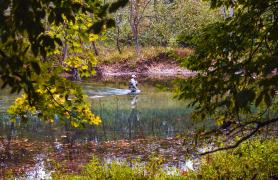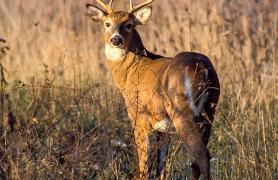
It was still dark when I unloaded my camera gear at B.K. Leach Memorial Conservation Area (CA) on a cold October morning in Lincoln County. My friend Bill Fritz was already glassing the north end of Pool 8, a wetland about a half-mile away.
“I see them,” Bill whispered.
“How can you see them; it’s pitch dark?” I asked. “Trust me,” he said, “They’re there.”
Earlier in the week, I had learned from my friends Andrew Reago and Christina McClarren that up to 10,000 American white pelicans had been roosting each evening at Leach CA. Andy and Chrissy are a preeminent St. Louis birding duo, so I knew the tip was golden. Although I had photographed Missouri’s migrating white pelicans before, I couldn’t resist an opportunity to witness such an aggregation of one of the largest birds in North America.
When Bill and I settled into our hide near the wetland, it was an hour before sunrise. The waiting would be easy as the sky was full of stars and an unexpected meteor shower was underway. Although we were confident the pelicans were roosting on the shallow pool, we couldn’t make them out in the dark or hear a sound. I told Bill all I could see was a triangle of land out in the water. My confidence waning, I suspected we’d been shut out, but Bill insisted he had seen the pelicans earlier under the light of the setting moon. Finally, I saw movement, a wing flap perhaps, then another. A moment later, we could hardly control our excitement as we realized the triangle of land was instead a mirage emanating from countless American white pelicans.
Our hide was facing east, directly into the warm glow of the burgeoning sunrise. It wasn’t long before we could make out individual pelicans preening and squabbling, their typical morning routine. Soon most of them would depart for breakfast in nearby pools and sloughs packed with forage fish from a Mississippi River flood earlier in the year.
I began photographing the pelicans as they stirred to life, already wishing I had opted for a hide on the east side of the wetland with the sun behind me. My regret was short-lived as small groups of pelicans began to rise from the wetland in stunning silhouette against the orange sky. I didn’t know how long the opportunity would last so I frantically twisted my camera loose from my 500 mm lens, locked it onto a wider 300 mm lens, and continued shooting as more and more pelicans rose into the radiance, each silhouette kinetic and unique.
Natural History
The American white pelican (Pelecanus erythrorhynchos), with its 9-foot wingspan, yellow-orange pouched bill, and bright orange legs and feet, is a massive and striking bird, especially when aloft. Clad in white with black wing tips and a neck that is permanently fixed in an S-shape, pelicans in flight are reminiscent of prehistoric flying reptiles. Breeding adults are even more impressive as they display a patch of yellow feathers on their chests and grow a vertical plate near the end of their bills that distinguishes them during the courtship season.
Pelicans are more graceful in flight than on the ground. After a fair amount of stomping and wing flapping, they take flight and join others to form a squadron that ascends in spirals, wings flashing brilliantly in the sky, a shimmering waltz of white on blue. The sight of pelicans aloft is so captivating that travelers often pull off onto the shoulder to revel in the elegant spectacle.
Although pelicans are gregarious, rarely spotted alone, they aren’t as noisy as other birds. During skirmishes for prey or the perfect loafing spot, pelicans sometimes open their bills widely in protest, only to emit a grunt similar to that of a great blue heron but more resonant than raspy. Most of the sound coming from a large group of pelicans is from wing flapping, an apparent communication technique.
The pelicans that visit Missouri each year breed in summer in Canada and several northern states. They typically nest on the ground, often on islands of remote lakes, and feed in shallow lakes, rivers, and marshes. I envy northern anglers who have stumbled across a group, or crèche, of orange pelican chicks from different nests. At the end of the breeding season, pelicans migrate south through the Great Plains and along the Mississippi River to their wintering grounds along the Gulf Coast. Many of them stop in Missouri along the way.
During their spring and fall migrations, pelicans visit Missouri’s reservoirs, large rivers, and wetlands where they feed and rest. Historically, pelican viewing in Missouri was mostly in the western part of the state, but over the past couple decades, pelicans have become much more common along the Mississippi River in eastern Missouri. I’ve found the best months to view pelicans are March and April in spring, and September and October in fall. Don’t be surprised to find pelicans later in winter in Missouri though, especially on ice-free, flowing rivers where fish can be captured. I’ve photographed pelicans fishing the Mississippi River on bitterly cold January days.
Feeding
Feeding behavior of American white pelicans is as fascinating as their aerial displays. Unlike the brown pelican, a coastal species that dives for its food, white pelicans scoop fish from the water, sometimes tipping their heads down and tails up like a dabbling duck. The white pelican’s diet consists mostly of minnows, shad, carp, catfish, and other fish but they are known to consume salamanders and crayfish when the opportunity arises.
Pelicans feed mostly by sight during the day, but they sometimes feed at night, using their bills to feel for prey. Typically, an individual floats in place, staring intently into the water until it spies a fish near the surface. Next, the pelican drops its pouched bill like a fish net into the water and bursts forward, catching its prey. The upper mandible of the white pelican’s bill is equipped with a hook to aid in retention of its catch.
Pelicans often employ group feeding behavior by forming a semicircle, closing in on their prey, and herding them into shallow water or a cove where they are captured. During the process, pelicans use a technique referred to as “synchronous feeding” as they simultaneously drop their bills into the water over and over as they close on their quarry. Once a fish is scooped up by an individual, the coordinated approach of the group breaks down as other pelicans move in to steal the prize. I’m often reminded of barnyard chickens as I watch pelicans tussle for a fish.
Pelicans consume about 3 pounds of fish a day, often in several meals of smaller fish but not always. Several years ago, I was photographing waterfowl on a January morning along the Upper Mississippi Conservation Area in St. Charles County when a pod of pelicans swam into the cove near my hide. It was so cold I could see chunks of ice on their backs from previous feeding maneuvers. To my surprise, their quarry that morning turned out to be nonnative invasive carp, specifically 3- to 4-pound silver carp.
I watched as the pelicans formed a semicircle and started moving toward the shoreline, their bills partially submerged in the water. At first, I assumed they were corralling shad, but I was wrong. As the pelicans closed on the bank, an individual drew its bill from the water with its catch, an invasive carp so large that its tail end protruded from the pelican’s pouch. I was astounded!
As the feeding frenzy continued, I observed another individual trying to swallow a large fish. When it raised its bill to the sky and swallowed, the fish’s tail still bulged against the wall of the pelican’s pouch. When the pod finally broke ranks and began leaving the cove, several others were in the same predicament, still attempting to swallow their catches, pouches grotesquely contorted by the tail ends of their prey.
Whether the increasing number of visiting pelicans to eastern Missouri is related to the unintended introduction of nonnative invasive carp into the Mississippi River is a subject of discussion among biologists and river scientists. Regardless, it was heartwarming to see native pelicans doing their part to control an invasive fish species.
The morning after Bill and I observed the roosting pelicans, I was back at the wetland pool again but on the opposite shore with the sun behind me. I waited for daylight in my turkey hunting chair, my tripod and 500 mm lens draped over my lap. Even though I couldn’t hear a sound, I knew the pelicans were present, already stirring and preening. When the sun finally came, it cast a golden glow on the tightly packed birds, a scene I’ll never forget. I watched as they started their day, flapping their wings, snapping their bills, and making false starts into the sky, sociable as always but ever-so-quiet.
American white pelicans are as compelling as trumpeter swans, or even bald eagles, and are revered by many Missourians. I doubt a young boy or girl could forget the sight of a pelican scooping a huge fish from a Missouri lake or river, water cascading from its pouch. Pelicans are not only important to a balanced aquatic ecosystem; they are grand ambassadors of the natural world.
Conservation Status of American White Pelicans
According to the North American Breeding Bird Survey, American white pelicans were in decline during the first half of the 1900s, but their numbers have significantly rebounded. The Cornell Lab of Ornithology lists historical threats to pelicans as human disturbance and destruction of breeding grounds, and illegal shooting due to concern that pelicans compete for fish with humans. These threats have been reduced by better habitat management and education about their life history. American white pelicans are considered of low conservation concern.
Finding Pelicans
I hope by the time you’ve read this you are eager to get out and see some American white pelicans yourself. Following is a list of suggested viewing locations:
- Loess Bluffs National Wildlife Refuge
- Big Lake State Park
- Riverlands Environmental Demonstration Area
- Schell-Osage Conservation Area
- Swan Lake National Wildlife Refuge
- Stockton Lake
- Mark Twain Lake
- Truman Lake
- Eagle Bluffs Conservation Area
Photographs, observations, and reminiscences
















Also In This Issue

Experience fall by floating and fishing your way down an Ozark stream

Limiting chronic wasting disease in Missouri deer
And More...
This Issue's Staff
Stephanie Thurber
EDITOR
Angie Daly Morfeld
ASSOCIATE EDITOR
Larry Archer
PHOTOGRAPHY EDITOR
Cliff White
STAFF WRITERS
Bonnie Chasteen
Kristie Hilgedick
Joe Jerek
DESIGNERS
Shawn Carey
Marci Porter
PHOTOGRAPHERS
Noppadol Paothong
David Stonner
CIRCULATION MANAGER
Laura Scheuler






















